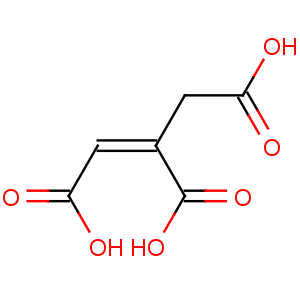Title: Aconitic Acid
CAS Registry Number: 499-12-7
CAS Name: 1-Propene-1,2,3-tricarboxylic acid
Synonyms: equisetic acid; citridic acid; achilleic acid
Molecular Formula: C6H6O6
Molecular Weight: 174.11
Percent Composition: C 41.39%, H 3.47%, O 55.14%
Literature References: Found in leaves and tubers of
Aconitum napellus L.,
Ranunculaceae, in various species of
Achillea (Compositae) and
Equisetum (Equisetaceae), in beet root, and in sugar cane. Can be prepd commercially from calcium magnesium aconitate recovered from sugar cane juice: McCalip, Seibert,
Ind. Eng. Chem. 33, 637 (1941); from molasses: Regna, Bruins,
ibid. 48, 1268 (1956). Most of the commercial aconitic acid is, however, manufactured by sulfuric acid dehydration of citric acid: Bruce,
Org. Synth. coll. vol. II, p 12 (1943); by using methanesulfonic acid instead of sulfuric: Cranston,
US 2727066 (1955 to Daniel F. Kelly). Aconitic acid prepd by any of the above methods has the
trans-configuration which is the form described here.
Properties: Leaflets, plates from water. Decompn 198-199° (capillary inserted in oil bath at 190°); decompn 204-205° (capillary in oil bath at 195°); decompn 209° (electrically heated bar). K1 at 25° = 1.58 ′ 10-3; K2 = 3.5 ′ 10-5. One gram dissolves in 5.5 ml water at 13°, in 2 ml water at 25°. Soluble in 2 parts of 88% alcohol at 12°. Slightly sol in ether.
Derivative Type: Triethyl ester
Properties: bp5 155°.
Boiling point: bp5 155°
Derivative Type: Tributyl ester
Properties: bp3 190°.
Boiling point: bp3 190°
Use: Manuf itaconic acid. As plasticizer for buna rubber and plastics. Used in form of triethyl or tributyl ester.

